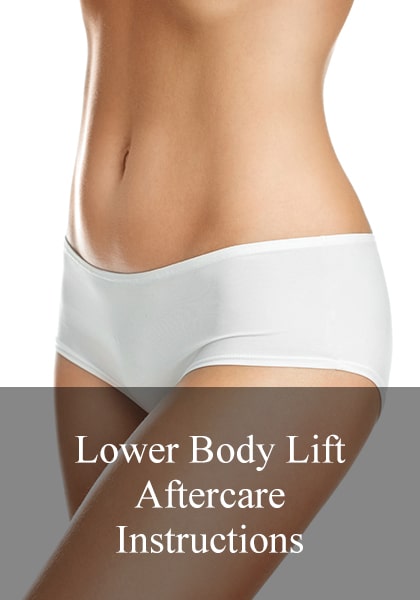

A body lift is a circumferential body contouring procedure which can address the abdomen, outer thighs, and buttock areas. Body contouring procedures help to shape and contour areas by removing excess skin and fat. Patients who have gained and lost a significant amount of weight, such as after pregnancy or after weight loss through diet and exercise or bariatric surgery are common candidates for this cosmetic procedure.
- A body lift in women typically combines three procedures in one and incorporates an abdominoplasty (tummy tuck), outer thigh lift, and a buttock lift.
- In male patients, a belt lipectomy is a more appropriate procedure which removes excess skin and fat along the waistline without lifting and shaping the buttocks and hips.
Dr. Trussler in Austin, TX offers multiple body lift techniques which can be applied to whatever type of body contouring issues you have.
What Are My Body Lift Options?
The circumferential body lift addresses areas of excess skin, deposits of fat, and central muscle laxity called a diastasis recti. Dr. Trussler will listen to your goals of the procedure and identify areas of concern on the abdomen, waistline, thighs, and buttocks to formulate an individualized body lift plan that suits you. There are multiple types of body lift techniques which mainly depend on the amount and region of excess skin.
Abdominoplasty
Abdominoplasty is the front component of the body lift and addresses upper and lower abdominal skin excess, as well as fatty deposits along the waistline and muscle laxity. The procedure is performed through a lower abdominal incision to remove excess skin above and below the umbilicus (belly button) and tighten the central abdominal muscles. The outer incision line is continued into the outer thigh lift incision.
Outer Thigh Lift
Outer Thigh Lift addresses outer thigh skin excess and fat deposits commonly referred to as “saddlebags”. This procedure is performed as the outer component of the circumferential procedure and involves a lower waistline scar. The outer thighs are typically contoured with skin lifting and tightening, as well as outer thigh liposuction.
Buttock Lift
Buttock Lift is the back component of the body lift and addresses excess skin, flattening and sagging of the buttock area. The procedure is performed through an upper arching buttock incision which helps to shape and lift the buttocks, waist and outer thigh area. Further shape and volume can be added to the buttock lift with a buttock auto-augmentation procedure which utilizes the buttock tissue to fill areas of buttock flattening.
Considerations
The best candidates for all types of body lift surgery are healthy, non-smoking, in good physical condition with areas of fat and/or loose skin that have not responded well to diet and exercise. Body contouring is common in women who have had children and those patients who have lost a significant amount of weight. Ideally, women should consider a body lift after they finished having children because carrying a baby can reverse the effects of an abdominoplasty on the abdominal wall. Post-baraitric surgery patients should be at a stable weight for over 6 months prior to considering body contouring procedures.
Other considerations in body contouring surgery are the presence of pre-existing scars and the presence of hernias. The most common scar encountered in abdominoplasty is a C-section, which is usually removed with the procedure, however upper abdominal scars and umbilical scars may make a body lift have a higher risk of healing issues. Hernias are defects or holes in the abdominal wall which are commonly located at the belly button, or maybe a complication of previous surgery. Small hernias can be repaired at the time of the abdominoplasty component of the body lift.
Expectations
Realistic expectations are important when considering body lift surgery. Dr. Trussler will listen to your goals and factor into the extent and location of excess abdominal, thigh and buttock skin to help come up with a body contouring procedure that is right for you. No matter what incision type of body lift is performed there will be a scar. Scar quality and how the scar heals depends on what is done before, during and after body lift surgery. Choosing the right incision type for your body lift and Dr. Trussler’s surgical experience to help with scarring, but good nutrition, smoking cessation, avoidance of sun, limiting activity, and active scar care all help to improve the healing process. Dr. Trussler will provide detailed instructions for your body lift procedure.
Surgery
Body Lifts take approximately five hours under general anesthesia depending on what procedure is performed and the extent of excess skin, fat, and abdominal muscle laxity. Dr. Trussler does recommend at least one night in the aftercare unit to help make the body lift recovery safe and comfortable. The areas of skin excision and the incision placement are typically marked during the pre-operative appointment. The body lift procedure is started with the patient in the face-down position (prone) to complete the buttock and outer thigh lifts.
- The buttock area is lifted and shaped through an arching upper buttock incision with excess skin removed and internal sutures are placed for contour. Liposuction of the thigh is commonly performed to help thin the fatty deposits of the thigh and help release the excess skin.
- The outer thigh skin excess is then pulled up and removed, the outer thigh lift incisions are closed with two to three layers of absorbable sutures, as well as deep supportive stitches. The outer incisions are temporarily closed and then the patient is repositioned in the backside down position (supine) to complete the abdominoplasty component of the body lift.
- The abdominoplasty is designed to recontour the entire abdomen and can tighten skin above and below the belly button. The abdominal muscle is typically tightened and the belly button is repositioned. The incision is kept in a very low position and wraps around to connect with the outer hip incision. The specific areas of skin laxity are corrected and the underlying abdominal muscle is tightened to help flatten the abdomen and tighten the waistline. Liposuction may be added to help decrease fat deposits to help thin and sculpt these stubborn areas.
Dr. Trussler closes all incisions with deeper supporting stitches and then aligns the scars with stitches under the skin. Drains are placed in the procedures to help collect fluid that accumulates after the operation. The torso is flexed in this procedure to decrease tension on the healing skin. A compression garment is placed at the conclusion of the operation to hold the contour in place and avoid collections of fluid.
After Care & Recovery
After a body lift procedure, patients will likely experience mild soreness and swelling for a few days. Dr. Trussler advises at least a one night stay in the aftercare unit to encourage early ambulation and make the first night after the surgery comfortable. Mothers have two or more people to worry about at home, but in the first week after a body lift, it is important to have enough help at home so moms can focus on their own healing and recovery.
- Dr. Trussler does make it easy to recover after a body lift by limiting the amount of care needed on the incisions and surgical areas for the first week.
- In general, the waist is kept in a flexed position, and a compressive garment is kept on the abdomen and thighs.
- After the first week, drains and stitches are removed and the abdominal compression garments are downsized.
Most patients will be able to return to caring for their children, work and light exercise within two weeks, although vigorous exercise and other strenuous activity should be avoided for about a month. Heavy lifting greater than 30 lbs is limited for 6 weeks. Dr. Trussler will provide you with specific instructions for your individual recovery.
The results of a body lift are visible immediately after surgery and will continue to improve as swelling subsides and scars fade. The body shape will evolve over a three month period. Scar treatment will be initiated at the 3-week visit and may be continued for 3 to 6 months after the operation, or until the scars soften and fade.
*Disclaimer: Results and patient experience may vary.
Contact Us
Whether you have a question or would like to setup a body lift consultation, Dr. Trussler and his staff are here to help. Please fill out our contact form, or call our Austin office at 512-450-1077 to schedule an appointment. Start your journey to not only looking, but feeling better today!
Publication
- Hatef, DA, Trussler, AP, Kenkel, JM. Procedural Risk for Venous Thromboembolism in Abdominal Contouring Surgery: A Systematic Review of the Literature. Plast Reconstr Surg. 2010 Jan;125(1):352-362.

